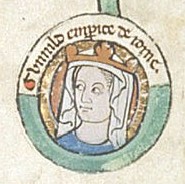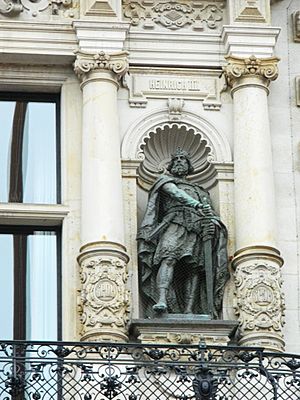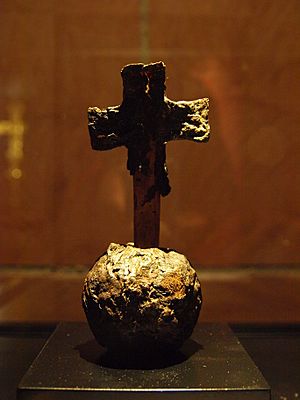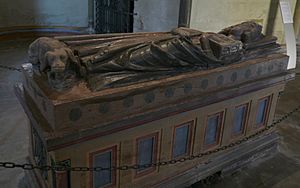Henry III, Holy Roman Emperor facts for kids
Quick facts for kids Henry III |
|
|---|---|
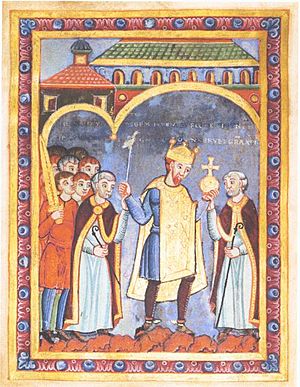
Henry with the symbols of rulership attending the consecration of the Stavelot monastery church on 5 June 1040, mid-11th century miniature
|
|
| Holy Roman Emperor | |
| Reign | 25 December 1046 – 5 October 1056 |
| Coronation | 25 December 1046 St. Peter's Basilica, Rome |
| Predecessor | Conrad II |
| Successor | Henry IV |
| King of Germany (Formally King of the Romans) |
|
| Reign | 14 April 1028 – 5 October 1056 |
| Coronation | 14 April 1028 Aachen Cathedral |
| Predecessor | Conrad II |
| Successor | Henry IV |
| King of Italy | |
| Reign | 4 June 1039 – 5 October 1056 |
| Predecessor | Conrad II |
| Successor | Henry IV |
| King of Burgundy | |
| Reign | 4 June 1039 – 5 October 1056 |
| Predecessor | Conrad II |
| Successor | Henry IV |
| Born | 28 October 1016 |
| Died | 5 October 1056 (aged 39) Bodfeld |
| Burial | Imperial Palace of Goslar (heart); Speyer Cathedral (body) |
| Spouse | Gunhilda of Denmark Agnes of Poitou |
| Issue | Beatrice I, Princess-Abbess of Quedlinburg Adelaide II, Princess-Abbess of Quedlinburg Henry IV, Holy Roman Emperor Conrad II, Duke of Bavaria Judith, Queen of Hungary Matilda of Swabia |
| House | Salian Dynasty |
| Father | Conrad II, Holy Roman Emperor |
| Mother | Gisela of Swabia |
| Religion | Roman Catholicism |
| Signum manus (1049) |  |
Henry III (born October 28, 1016 – died October 5, 1056) was a powerful ruler. He was known as the Black or the Pious. He served as the Holy Roman Emperor from 1046 until his death in 1056. Henry was part of the Salian Dynasty, a famous royal family. He was the oldest son of Emperor Conrad II and Gisela of Swabia.
Henry was prepared for his future role from a young age. His father made him Duke of Bavaria in 1026. In 1028, he became a co-ruler, sharing power with his father. Ten years later, in 1038, he also gained control of Swabia and the Kingdom of Burgundy. When his father died in 1039, Henry smoothly took over as ruler. He also became Duke of Carinthia and King of Italy. Henry followed his father's ideas, focusing on "courage and honesty." This made the idea of kingship seem very special and holy.
In 1046, Henry solved a big problem in the church. There were three different popes at the same time! Henry ended this "papal schism." He was then crowned Emperor by Pope Clement II. He also helped the Holy See (the Pope's government) become more independent from Roman nobles. This laid the groundwork for the Pope's authority across the empire. Henry also made sure he had strong control over the duchies (large territories). This led to long conflicts in Lorraine, but Henry won. He died at only 39 years old. Some historians believe his last years showed the start of problems for the Salian rulers.
Contents
Henry's Early Life
Henry was born on October 28, 1016. His father was Conrad of Worms, a noble from Franconia. His mother was Gisela of Swabia. Gisela came from the famous Charlemagne family. She had a strong claim to rule Swabia and Burgundy. While his father could not read, Henry's mother made sure he received a good education. Henry learned to read and write.
In 1024, the last ruler of the Ottonian family, Henry II, died. German nobles chose Conrad of Worms, Henry's father, as their new king. Some nobles fought against King Conrad, but he defeated most of them. In 1026, Henry's mother, Gisela, helped her son, then eight years old, to speak to his father on behalf of a rebellious stepson. This helped bring peace.
In 1027, King Conrad named Henry as his future heir. A year later, before going to Italy, Conrad put Bruno, Bishop of Augsburg, in charge of Henry's education. Bruno was a brother of Emperor Henry II. He was perfect for teaching Henry about royal duties and traditions. Bruno even took Henry to Rome. They both attended Conrad's coronation as Emperor in 1027.
Becoming Co-Ruler
Emperor Conrad II wanted to make the king's power stronger in Germany. He convinced the nobles of Bavaria to accept Henry as their duke in 1027. Henry was only ten years old, which was very unusual for a duke. In 1027, the Emperor also sent a messenger to Constantinople. He hoped to find a bride from the Byzantine royal family for Henry. But the messenger died, and the talks ended.
In 1028, the "clergy and the people" chose Henry to be co-ruler with his father. Pilgrim, Archbishop of Cologne, crowned Henry as king in Aachen. After this, Henry was called the "hope of the empire" on his father's official seals. This was a custom from the Byzantine Empire.
Henry's tutor, Bishop Bruno, died in 1029. Conrad then appointed Egilbert, Bishop of Freising, as Henry's new teacher. Bavaria had some conflicts with Hungary. In 1030, Conrad led an army into Hungary but had to retreat. He left the problem to the twelve-year-old Henry. Bishop Egilbert helped Henry negotiate a peace treaty with Stephen I of Hungary. Henry accepted the terms and signed the treaty in 1031. Egilbert continued to guide Henry until 1033.
In 1032, Rudolph III of Burgundy died. Emperor Conrad II claimed the title to Burgundy. After some military campaigns, Conrad officially added the Kingdom of Burgundy to the Holy Roman Empire in 1034.
Henry got engaged to Gunhilda of Denmark on May 18, 1035. She was the daughter of Canute the Great, King of Denmark, England, and Norway. Their wedding took place in Nijmegen in 1036. In 1038, Henry went to Italy to help his father. On their way back, Gunhilda died from a disease. In 1039, Emperor Conrad II also died. Henry then became the sole king and was expected to become emperor soon.
Henry's Rule as King and Emperor
Beginning His Reign
Henry started his rule by traveling through his lands. He visited the Low Countries and Cologne. He then went to Saxony and made the town of Goslar a future imperial home. He led an army into Thuringia to deal with problems caused by Duke Bretislaus I of Bohemia.
Henry also visited Bavaria. When he left, King Peter Urseolo of Hungary sent raiding parties into Swabia. Henry held a meeting in Ulm where Italian princes recognized his authority. He then returned to Ingelheim. There, he was recognized by people from Burgundy and by Aribert, Archbishop of Milan. Henry also inherited the Duchy of Carinthia. This made him duke of three major regions: Bavaria, Swabia, and Carinthia. He was also king of Germany, Burgundy, and Italy.
Fights with Bohemia and Hungary
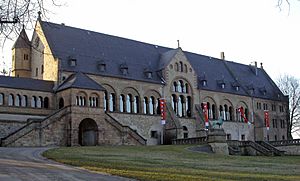
In 1040, Henry led his first military campaign as king into Bohemia. He wanted to stop Bretislav I from creating a separate church region. Henry gathered his army and set out. But he was ambushed in the Bohemian Forest and had to retreat with many losses. He later made peace with Bretislav. After this, Henry appointed Suidger, who would later become Pope Clement II, as bishop of Bamberg.
In 1040, King Peter of Hungary was overthrown. He fled to Germany, and Henry welcomed him. Henry then prepared another campaign into Bohemia. In 1041, he won and signed a peace treaty with Bretislav.
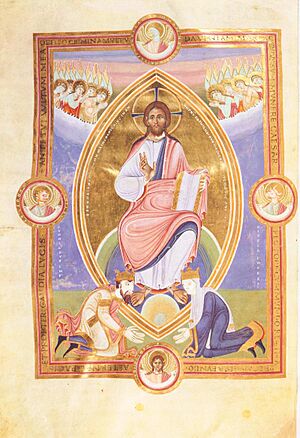
In 1042, Henry learned of Hungarian raids into Bavaria. He gave the duchy to Henry VII. At Cologne, the royal princes agreed to declare war on Hungary. Henry then sent a wedding group to Agnes de Poitou. In September 1042, he successfully took control of western Hungary. He put a cousin in charge, but this person was quickly removed after Henry left.
Henry then returned to Goslar. He received visitors from other lands. He met with Duke Bretislav. He also met with ambassadors from Casimir I of Poland. Henry then went to the French border to meet King Henry I of France. They likely discussed Henry's upcoming marriage. Henry then returned to Hungary. He forced Aba to give back lands along the Danubian river. These lands had been lost by his father in 1030. This border stayed between Hungary and Austria until 1920.
Promoting Speyer
Henry's mother, Gisela, died in March 1043. She was buried in Speyer. Henry showed his deep religious faith at the funeral. He appeared barefoot and in tears, showing his humility. He wanted to prove he was a pious king. Henry greatly supported Speyer, even more than his father. He gave the church a beautifully illustrated gospel book, the Codex Aureus Escorialensis. The Dome of Speyer was expanded. A large burial area was created for future rulers.
In October 1043, Henry announced from the church in Konstanz Minster that everyone in his lands should respect the Peace and Truce of God. This day was called the "Day of Indulgence" or "Day of Pardon." Henry forgave all wrongs done to him and encouraged his people to do the same.
Marriage to Agnes of Poitou
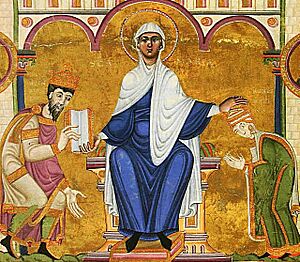
In 1043, Henry married Agnes of Poitou. She was the daughter of Duke William V of Aquitaine. Some church leaders were concerned because Agnes was related to Henry by blood. They were both descendants of Henry I the Fowler. Despite this, the marriage happened, and Agnes was crowned queen in Mainz.
Conflicts in Lorraine and Hungary
Henry spent the winter in Utrecht, where he again announced a day of forgiveness. In April 1044, Gothelo, Duke of Lower and Upper Lorraine, died. Henry wanted to reduce the power of the dukes. He appointed Gothelo's younger son, Gothelo II, as duke of Lower Lorraine. This was instead of Godfrey, Gothelo I's older son, who was already duke of Upper Lorraine. Godfrey, who had been loyal to Henry, rebelled. Henry tried to make peace between the brothers but failed. Henry believed that he, as king, had the right to choose who ruled these territories.
On July 6, 1044, Henry, with Peter Orseolo, entered Hungary. They fought against Samuel Aba's army. Aba's forces were not united and quickly broke apart. In Székesfehérvár, Peter became King of Hungary again. Aba was captured and killed. Henry then set up royal administration in Hungary.
After returning from Hungary, Godfrey of Upper Lorraine formed new alliances. He even allied with Henry of France. The emperor reacted quickly and called Godfrey to Aachen. Godfrey was found guilty and lost his duchy of Upper Lorraine. He fled and started a revolt. Henry spent the winter preparing for a campaign in Lorraine.
In early 1045, Henry led an army into Lorraine. He captured Godfrey's castle of Böckelheim. After taking several castles, Henry had to leave due to lack of supplies. He left soldiers in the ducal castles to prevent Godfrey from attacking. He then went to Burgundy. Godfrey had caused trouble in Burgundy by stirring up conflicts. When Henry arrived, Burgundy was fully brought into the empire.
At the Peak of His Power
Henry settled political issues with the nobles in Italy at Augsburg. In Goslar, he appointed new dukes and counts. During preparations for a trip to Hungary, a wooden floor collapsed, killing Bruno, Bishop of Würzburg. In Hungary, King Peter gave Henry the Golden Lance. Peter also swore loyalty to Henry. The kingdoms of Germany and Hungary were at peace. In July, Godfrey surrendered and was imprisoned.
War in Lorraine
Henry became ill in October. So, some nobles chose Henry I of Lorraine as Henry III's possible successor. However, Henry III recovered. In 1046, Henry's old advisor, Eckard of Meissen, died. Henry then gave Meissen to William.
Henry then went to Lower Lorraine. There, Gothelo II had died. Dirk IV of Holland had taken Flushing. Henry led a campaign against Count Dirk and got Flushing back. He gave it to Bernold, Bishop of Utrecht. Henry then returned to Aachen to decide the future of Lorraine. Henry gave Godfrey his duchy back. But he transferred the county of Verdun to the bishop of the city, which angered Godfrey. Henry gave the lower duchy to Frederick, Duke of Lower Lorraine. He also appointed Adalbert as archbishop of Bremen.
The idea of a German court trying an Italian bishop was very controversial. This issue later led to the Investiture Controversy. This was a big fight over who could appoint church leaders. Henry then went to Saxony. He held courts and appointed his daughter Beatrice as abbess. He also ended a conflict between Siemomysł, Duke of Pomerania and Casimir of Poland.
Becoming Emperor

Henry gathered the important princes of the empire and went to Italy. In Rome, there were three different popes: Benedict IX, Sylvester III, and Gregory VI. They were all fighting for the title. Henry went to Sutri and held a meeting on December 20, 1046. He removed all three popes from their positions. In Rome, he held another meeting. He declared that all Roman priests were not fit for office. Since Adalbert of Bremen refused the honor, Henry appointed Suidger of Bamberg as the new pope. Suidger took the name Clement II.
On Christmas Day 1046, Clement was made pope. Henry and Agnes were then crowned emperor and empress. The people of Rome gave Henry a special honor. Henry visited Frascati and took control of castles belonging to the Crescentii family. With the pope, he traveled to southern Italy. He changed many of his father's policies there.
In Capua, Henry was welcomed by Prince Guaimar IV of Salerno. However, Henry gave Capua back to Prince Pandulf IV. This was a very unpopular decision. Henry made Drogo of Hauteville, a Norman leader, a direct vassal (someone who serves the emperor) of the imperial crown. He did the same for Ranulf Drengot. This took away power from Guaimar. These decisions made Henry unpopular among the Lombards. Henry finished his trip in Italy in May 1047.
Henry's Appointments and Conflicts
When he returned to Germany, Henry filled empty positions. He gave his last personal duchy, Carinthia, to Welf. He appointed many bishops and other church leaders.
In July 1047, Henry was in Metz when Godfrey rebelled again. Godfrey now had allies like Baldwin of Flanders. Henry gathered an army and went north. He gave Adalbert of Bremen Godfrey's former lands. Henry made peace with the new king of Hungary, Andrew I. He then moved into the Netherlands. At Flushing, he was defeated by Dirk. The Hollanders attacked Charlemagne's palace at Nijmegen and burned Verdun. Godfrey then publicly apologized and helped rebuild Verdun.
The rebels attacked Liège, which was bravely defended by Bishop Wazo. Henry gave Upper Lorraine to Adalbert and left. The pope had died. Henry chose Poppo of Brixen to be the next pope, who took the name Damasus II. Henry gave Bavaria to Cuno. In January 1048, he gave Swabia to Otto of Schweinfurt. Henry met Henry of France again. Envoys from Rome came seeking a new pope, as Damasus had died. Henry chose Bruno of Toul, who became Leo IX. Under Leo IX, the Church would later divide into East and West. Henry's final appointment was Gerard of Chatenoy for Lorraine.
Peace in Lorraine
The year 1049 was successful. Dirk of Holland was defeated and killed. Adalbert of Bremen made peace with Bernard II, Duke of Saxony. He also made a treaty with Sweyn II of Denmark. With help from Sweyn and Edward the Confessor of England, Baldwin of Flanders was attacked by sea. He could not escape Henry's army. In Cologne, the pope removed Godfrey and Baldwin from the church. Godfrey left his allies and was imprisoned again by the emperor. Baldwin also gave in to Henry's pressure. Finally, the war in the Low Countries and Lorraine ended.
Henry's Final Years
In 1051, Henry led a third campaign against Hungary. But his troops suffered a major defeat. They fled over hills now called "Vértes" ("Armoured") because armor was found there. In Lower Lorraine, Lambert, Count of Louvain, and Richildis caused trouble. Godfrey was released and given Lower Lorraine to keep the peace.
In 1052, Henry led a fourth campaign against Hungary. He tried to capture Pressburg but failed. The Hungarians sank his supply ships on the Danube river. Henry could not continue his campaign and never tried again. At Christmas 1052, Cuno of Bavaria was removed from his position for fighting with Gebhard III, Bishop of Regensburg. Cuno rebelled.
Last Wars in Germany
On June 26, 1053, Henry's young son, Henry, born in 1050, was chosen as king of Germany. Andrew of Hungary almost made peace, but Cuno convinced him not to. Henry made his young son duke of Bavaria. He then went to deal with the ongoing rebellion. Henry sent another army to help Pope Leo in Italy against the Normans. But Leo was defeated by the Normans in 1053.
In 1054, Henry traveled north to deal with Casimir of Poland. He gave Silesia from Bretislav to Casimir. Bretislaus remained loyal to Henry. Henry then crowned his young son in Aachen on July 17. He then marched into Flanders, as the two Baldwins had rebelled again. The campaign in Flanders was successful.
Bretislav, who had regained Silesia, died in 1054. Henry could now focus on other matters. He returned to Goslar, the city where his son was born. He had made Goslar a grand imperial and church center. He spent Christmas there. He appointed Gebhard of Eichstedt as the next pope, who took the name Victor II. He was the last of Henry's four German popes.
Preparing for His Death
In 1055, Henry went south to Italy again. Boniface III of Tuscany, a loyal ally, had died. His widow, Beatrice of Bar, had married Godfrey of Lorraine in 1054. First, Henry gave Spitignev, the son of Bretislaus, to the Bohemians as duke. Spitignev swore loyalty, and Bohemia remained a strong part of the empire. By Easter, Henry arrived in Mantua. He held several courts and sent out officials to bring order. Godfrey, the reason for the visit, was not well received and returned to Flanders. Henry met the pope in Florence. He arrested Beatrice for marrying a traitor, and her daughter Matilda.
Henry returned to Germany, which was in chaos. A strong ally against Cuno in Bavaria, Gebhard of Regensburg, was involved in a plot against the king. Cuno died of the plague, and Welf soon followed. Baldwin of Flanders and Godfrey rebelled again. Henry's rule was changing. Old enemies and friends were dying.
Herman of Cologne died. Henry appointed his confessor, Anno, as Herman's successor. Henry of France met the emperor for a third time in May 1056. The French king challenged Henry to a single fight. Henry left during the night. Once back in Germany, Godfrey made his final peace. Henry then went northeast to deal with a Slavic uprising. He fell ill on the way. He freed Beatrice and Matilda. He made those with him swear loyalty to his young son, Henry. He also spoke to the pope, who was present.
On October 5, 1056, Henry died at Bodfeld, his hunting lodge. He was not yet forty years old. His heart was taken to Goslar. His body was taken to Speyer, to rest next to his father's in the cathedral. Henry was one of the most powerful Holy Roman Emperors. His authority as king in Burgundy, Germany, and Italy was rarely questioned. His power over the church led to later conflicts for his son. He managed to unite many duchies under his control. However, some say his reign failed because he left big problems for his successors. The Investiture Controversy was largely a result of his church policies. His most lasting monument is the impressive palace in Goslar.
Family and Children
| German royal dynasties | |||
| Salian dynasty | |||
| Chronology | |||
| Conrad II | 1024 – 1039 | ||
| Henry III | 1039 – 1056 | ||
| Henry IV | 1056 – 1105 | ||
| Henry V | 1105 – 1125 | ||
| Family | |||
| Salian dynasty family tree Family tree of the German monarchs |
|||
| Succession | |||
| Preceded by Ottonian dynasty |
Followed by Süpplingenburg dynasty |
||
Henry III was married twice and had at least eight children:
- With his first wife, Gunhilda of Denmark:
- Beatrice (1037 – July 13, 1061), abbess of Quedlinburg and Gandersheim
- With his second wife, Agnes:
- Adelaide II (1045, Goslar – January 11, 1096), abbess of Gandersheim from 1061 and Quedlinburg from 1063
- Gisela (1047, Ravenna – May 6, 1053)
- Matilda (October 1048 – May 12, 1060, Pöhlde), married 1059 Rudolf of Rheinfelden, duke of Swabia
- Henry, his successor
- Conrad (1052, Regensburg – April 10, 1055), duke of Bavaria (from 1054)
- Judith (1054, Goslar – March 14, 1092 or 1096), married firstly 1063 Solomon of Hungary and secondly 1089 Ladislaus I Herman, duke of Poland
- With an anonymous concubine:
- Azela, mother of bishop Johannes of Speyer
See also
 In Spanish: Enrique III el Negro para niños
In Spanish: Enrique III el Negro para niños


